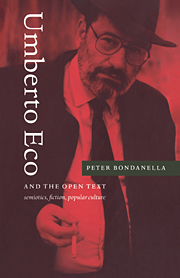Book contents
- Frontmatter
- Contents
- Preface
- ONE Umberto Eco's intellectual origins: medieval aesthetics, publishing, and mass media
- TWO The Open Work, Misreadings, and modernist aesthetics
- THREE Cultural theory and popular culture: from structuralism to semiotics
- FOUR From semiotics to narrative theory in a decade of radical social change
- FIVE “To make truth laugh”: postmodern theory and practice in The Name of the Rose
- SIX Interpretation, overinterpretation, paranoid interpretation, and Foucault's Pendulum
- SEVEN Inferential strolls and narrative shipwrecks: Six Walks and The Island of the Day Before
- EIGHT Conclusion
- Bibliography
- Index
FOUR - From semiotics to narrative theory in a decade of radical social change
Published online by Cambridge University Press: 23 October 2009
- Frontmatter
- Contents
- Preface
- ONE Umberto Eco's intellectual origins: medieval aesthetics, publishing, and mass media
- TWO The Open Work, Misreadings, and modernist aesthetics
- THREE Cultural theory and popular culture: from structuralism to semiotics
- FOUR From semiotics to narrative theory in a decade of radical social change
- FIVE “To make truth laugh”: postmodern theory and practice in The Name of the Rose
- SIX Interpretation, overinterpretation, paranoid interpretation, and Foucault's Pendulum
- SEVEN Inferential strolls and narrative shipwrecks: Six Walks and The Island of the Day Before
- EIGHT Conclusion
- Bibliography
- Index
Summary
The tumultuous political and cultural changes in Europe associated with the year 1968 began in France, even if ultimately inspired by events in the United States. Italy's conservative political and cultural establishment was profoundly changed by events that spilled over into the peninsula from France. Radical and unforeseen transformations in Italian political institutions, schools, universities, and factories resulted. While the disastrous impact of political terrorism from both the right and the left threatened to unravel the delicate social fabric underpinning Italy's democratic government, the screaming headlines announcing the latest exploit of the Red Brigades were ultimately not so important as a series of profound and permanent changes within Italian society during this period that all called established tradition and authority into question in a variety of ways and within a variety of cultural contexts. The year 1968 also marks Umberto Eco's move beyond an essentially structuralist analysis of popular culture in his pre-semiotic period to his active support of a theoretical perspective he considered more fruitful, that of semiotics.
Eco's first venture into semiotic theory resulted in the publication of La struttura assente (The Absent Structure). Subtitled “Introduction to Semiological Research,” The Absent Structure has never been translated completely into English, although one chapter of the work, “Series and Structure,” appears in the English version of The Open Work. The Absent Structure itself was an amplified and greatly modified version of another work, Appunti per una semiologia delle comunicazioni visive (Notes for a Semiology of Visual Communications, 1967) that Eco had first written for the use of students in his university lectures.
- Type
- Chapter
- Information
- Umberto Eco and the Open TextSemiotics, Fiction, Popular Culture, pp. 67 - 92Publisher: Cambridge University PressPrint publication year: 1997



